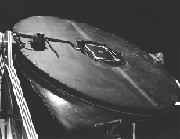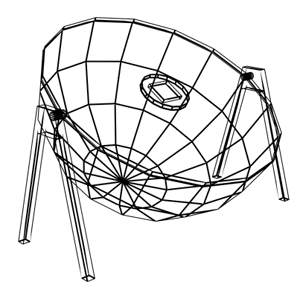Developed by : M. Andersen, J.-L. Scartezzini, C. Roecker, P. Loesch
General description
Most energy saving applications of advanced fenestration systems (daylight redirecting devices, solar blinds, etc.) require an accurate knowledge of their directional light transmission and reflection properties. These physical features can be described by:
- Bi-directional Transmission Distribution Functions (BTDF)
- Bi-directional Reflection Distribution Functions (BRDF)
A novel bi-directional photogoniometer, based on digital imaging techniques, was designed and set up at the EPFL in order to experimentally assess such functions. The apparatus uses a modern video image capture device (CCD digital camera), as well as powerful image analysis software (pattern recognition software) to reduce considerably the scanning time of BTDF/BRDF measurements in comparison to existing devices.

Figure 1 : View of the bi-directional photogoniometer designed for BTDF and BRDF experimental assessment
Figure 1 gives a view of this equipment located on the EPFL campus. The device, illustrated by a CAD drawing in Figure 2, has three major components :
- a calibrated light source that provides a collimated and spectrally optimal light beam (close to sunlight)
- a movable mechanical support that allows to modify the incident light beam on the fenestration sample in a continuous way for transmission measurements (BTDF assessment) and in a fixed way for reflection measurements (BRDF assessment)
- a computer controlled transmitted or reflected light detection device, made of a triangular flat screen linked to a CCD video camera
A detailed calibration and validation procedure was used to obtain an optimal experimental accuracy during BTDF and BRDF assessments. It includes a spectral, a photometric and a geometrical calibration of the overall digital imaging system, as well as several additional corrections.

PhD Thesis on this subject
- Innovative bidirectional video-goniophotometer for advanced fenestration systems / Andersen, Marilyne; Scartezzini, J.-L. (dir.). Ph.D. Thesis. – Lausanne : EPFL, 2004
Publications
- Design of a time-efficient video-goniophotometer combining bidirectional functions assessment for transmission and reflection / Andersen, M.; Roecker, C.; Scartezzini, J.-L. – In Solar Energy Materials & Solar Cells, num. 88 (2005), p. 97-118.
- Bi-directional transmission properties of Venitian blinds: experimental assessment compared to ray-tracing calculations / Andersen, M.; Rubin, M.; Powles, R.; Scartezzini, J.-L. – In Solar Energy, num. 78 (2005), p. 187-198.
- Inclusion of the specular component in the assessment of bidirectional distribution functions based on digital imaging / Andersen, M.; Scartezzini, J.-L. – In Solar Energy, num. 79 (2005), p. 159-167.
- BTDF measurements and ray-tracing simulations comparisons for prismatic glazing / Andersen, M.. Technical report. – 2003
- Méthode de caractérisation des propriétés optiques des vitrages complexes : l’imagerie numérique au service de la lumière naturelle / Andersen, M.. Technical report. – 2002
- Application of bi-directional optical properties of complex glazing and shading systems to daylight and solar control / Andersen, M.. Technical report. – 2002
- Comparison between ray-tracing simulations and bi-directional transmission measurements on prismatic glazing / Andersen, M.; Scartezzini, J.-L.; Rubin, M. D. – In Solar Energy, vol. 74, num. 2 (2003), p. 155-171.
- Bi-directional light transmission properties assessment for venetian blinds : Computer simulations compared to photogoniometer measurements / Andersen, M.; Scartezzini, J.-L.; Rubin, M. D.; Powles, R. C. – In Proceedings ISES Solar World Congress 2003, Gotebörg (SE), vol. 02, num. 35 (2003), p. 39.
- Bi-directional Photogoniometer for the Assessment of the Luminous Properties of Fenestration Systems / Andersen, M. et al.